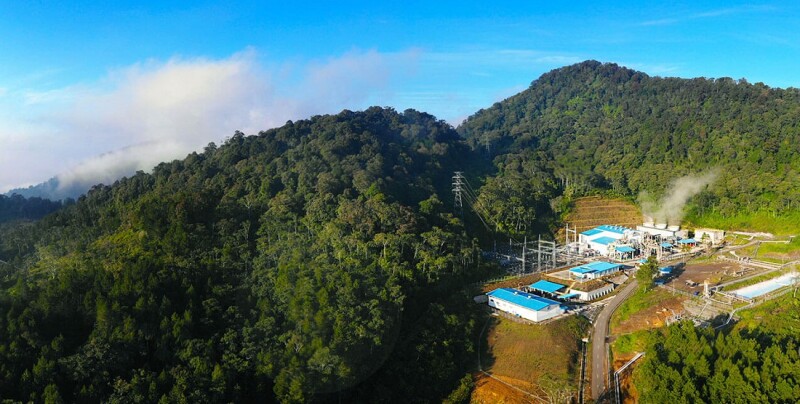Pertamina Geothermal Energy (PGE) has signed a joint study agreement (JSA) with Chevron New Energies International and Abu Dhabi’s Mubadala Energy to explore the geothermal potential in Kotamobagu, North Sulawesi, Indonesia.
The JSA signed on 14 November during Indonesian President Joko Widodo’s visit to Washington, DC, while en route to the Asia-Pacific Economic Cooperation (APEC) summit in San Francisco, offers a framework to study how the Kotamobagu Geothermal Working Area can supply electricity to the domestic market and potentially support hydrogen and ammonia production.
Southeast Asia’s largest economy, Indonesia aims to add 3.3 GW of installed geothermal capacity by 2030 to support a wider goal of generating at least 51% of its total energy from renewable sources by the same time. The country also aims to become carbon neutral by 2060, with renewable energy providing up to 85% of the energy mix.
As a region, Southeast Asia relies heavily on coal for electricity generation, according to the International Energy Agency’s (IEA) World Energy Outlook 2023 (Fig. 1). Quoting IEA’s STEPS analysis to assess whether a country’s policies can meet its climate targets, the outlook reported that Southeast Asia’s carbon emissions are expected to grow by 46%—the largest rate globally—from 2022 to 2050, largely because the region is one of the few where electricity generation from coal is expected to increase.
That’s where geothermal comes in, considering that geothermal energy provides only about 5% of Indonesia’s electricity and boosting that percentage could mean the difference between meeting or not meeting renewable energy targets.

Mining Energy Along Earth’s Ring of Fire
As a country that traverses the world׳s ring of fire and boasts at least 117 active volcanoes, Indonesia’s geothermal energy potential is estimated at about 40% of the world’s total, or about 28,617 MW, according to an article published in Renewable and Sustainable Energy Reviews in January 2016.
As of January 2023, Indonesia ranked second behind the US in terms of installed geothermal energy capacity according to ThinkGeoEnergy’s listing of Top 10 Geothermal Countries in 2022.
The country owes its energy-generating seismic and volcanic activity to subduction zones between the Eurasian Plate and the Indo-Australian Plate, much like Kenya and Ethiopia benefit from multiple plate collisions along the East African rift.
A subsidiary of Indonesia’s state-owned oil and gas champion Pertamina, PGE manages 12 geothermal working areas in Indonesia and associated operations that account for 82% of the country’s installed capacity, according to the company’s website.
In February of this year, Abu Dhabi’s clean energy company Masdar announced it had invested in Pertamina Geothermal Energy, marking its entry into Indonesia’s geothermal energy sector. Masdar is also developing the region’s largest floating solar facility—Indonesia’s 145-MW Cirata Floating Solar PV Plant.
“With our track record of delivering strategic energy resources in Indonesia for over a decade, we are excited about this partnership with PGE and Chevron to explore the expansion of geothermal energy,” said Mansoor Mohamed Al Hamed, CEO of Mubadala Energy, who was in Washington, DC, for the JSA signing.
From Gas Production to CCUS Storage
In July, Mubadala Energy had signed a separate framework agreement with PGE’s parent company, Pertamina, to explore opportunities for projects in carbon capture, use, and storage (CCUS) within the context of the two company’s existing portfolios of assets in Indonesia as well as assess possible joint investments in upstream projects to which CCUS could be applied.
Mubadala entered the Indonesian upstream in 2004 and today operates four offshore production sharing contracts (PSCs): in the Makassar Strait the Sebuku PSC with the producing Ruby gas field and the West Sebuku PSC, plus the Andaman I and South Andaman PSCs offshore Aceh. Mubadala also has a nonoperating interest in the Andaman II PSC, according to the Abu Dhabi company’s website.
ExxonMobil Eyes CCS While Indonesia Sorts Its Laws
CCUS was also on ExxonMobil’s agenda when it met with Pertamina separately during the Indonesian president’s visit to Washington, DC, ahead of APEC.
The companies signed an amendment to the Principals Agreement on 13 November, continuing the agreement made at the G20 summit in November 2022 on a proposed $2 billion carbon capture and storage (CCS) hub in the Java Sea with a capacity of up to 3 gigatons of CO2.
Under the agreement, Pertamina and ExxonMobil will continue to evaluate the western part of the Java Sea, specifically in the Asri and Sunda Basin, which is believed to offer significant geological storage in saline aquifers, capturing and injecting CO2 from domestic and regional industries, according to a Pertamina news release.
The government of Indonesia, meanwhile, is finalizing regulations to open up storage schemes for carbon from abroad to be stored in the country.
The Southeast Asian country has storage capacity of 8 gigatons of carbon in the depleted reservoirs, while an additional 400 gigatons of capacity is available if it uses its saline aquifers, according to Pertamina.
During the same trip, Pertamina, through three of its units, also agreed to share information with Chevron to potentially develop either CCS or CCUS sites in East Kalimantan, Reuters reported.


